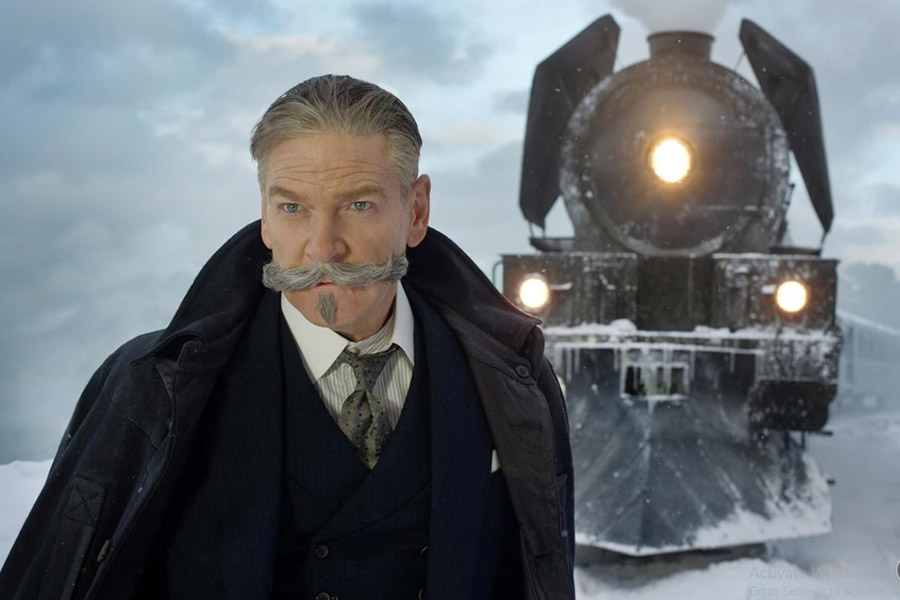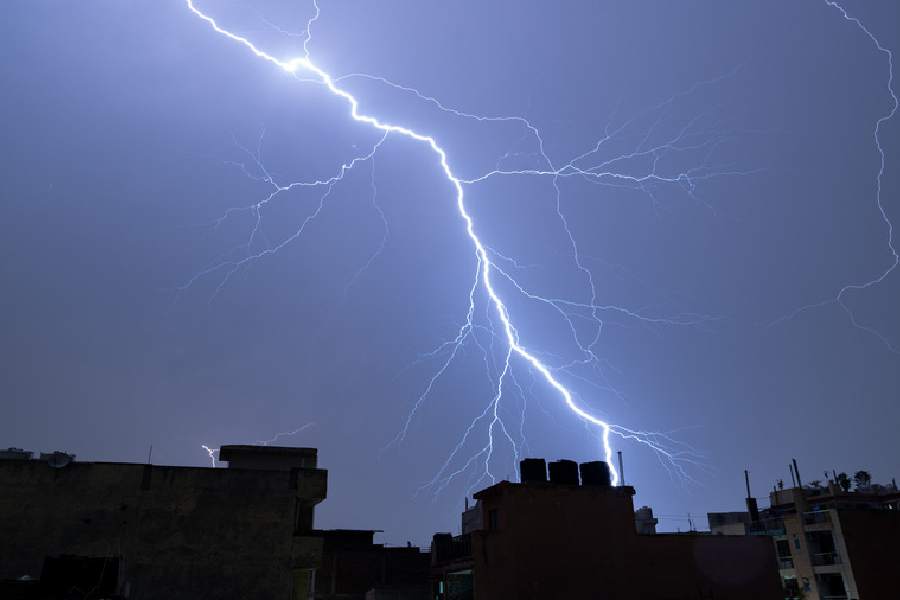Much like Byomkesh Bakshi in Bengali cinema — close to 20 films and OTT versions in the 14 years since 2009 — Agatha Christie is having a moment. Of course, unlike Byomkesh who went out of fashion in 1974 before a new generation of filmmakers made an epidemic of him, Dame Agatha has remained steadfast in the popularity stakes among filmmakers ever since the first film adaptation in 1928, The Passing of Mr Quinn.
However, with Kenneth Branagh’s 2017 film Murder on the Orient Express, there has been a marked upsurge in the number of films and TV series based on the works of the Queen of Crime. Branagh himself directed Death on the Nile in 2022 and barely a year later, his adaptation of Hallowe’en Party, A Haunting in Venice, is gearing up for release on Agatha Christie’s birthday, September 15. Sarah Phelps has created a series of striking shows based on Christie’s stories in the last few years. There have been three Indian adaptations — one each in Tamil, Telugu and Kannada — in the last decade and Vishal Bhardwaj’s series based on The Sittaford Mystery is scheduled to drop on SonyLIV by the end of the month.
Given the huge numbers of adaptations across formats — with over 30 films, and hundreds of TV shows — the quality is often suspect. No wonder Christie herself liked only two of the adaptations she watched during her lifetime. In fact, I haven’t been much of a fan of Branagh’s versions either which are rather overblown and fanciful. Here is a list of my favourite adaptations of stories, plays and novels by Agatha Christie.
And Then There Were None (1945)
This is the one Christie work that has had the most number of adaptations. The 1945 version directed by Rene Clair is by far the best of the lot, with a splendid ensemble cast and a script that balances humour with a light touch of the macabre. Even 80 years and more than a dozen adaptations (including four Indian) later, this remains the gold standard for Christie’s 1939 novel.
Witness for the Prosecution (1957)
Probably the greatest of Christie films, which is not surprising given that it was scripted and directed by Billy Wilder. Headlined by a compelling Charles Laughton as an ailing lawyer who agrees to represent a man accused of murdering the widow who has made him the heir to her fortune, and arguably Marlene Dietrich’s finest moment in cinema, this is a banger of a courtroom drama that incorporates elements of the noir and black comedy in a terrific script.
Murder on the Orient Express (1974)
Hollywood simply does not make it like this anymore. Kenneth Branagh’s 2017 film may have introduced one of Christie’s most ingenuous plots to a new generation of viewers with a cast of A-listers, but my vote for the best adaptation of this novel goes to Sidney Lumet’s 1974 version. Scene for scene, cast for cast, Lumet’s film outscores Branagh’s extravagant take. Lauren Bacall, Martin Balsam, Sean Connery, Ingrid Bergman (who won an Academy award), Jacqueline Bisset, John Gielgud, Anthony Perkins and Vanessa Redgrave are just some of the names who light up the hugely entertaining and stylish film. Above all, there is Albert Finney giving us one of the best Poirots ever. Along with Wilder’s Witness for the Prosecution, this was Christie’s personal favourite of adaptations of her works, though she was miffed with Poirot’s moustache.
The Guy Hamilton Christies: The Mirror Crack’d (1980) and Evil Under the Sun (1982)
Two star-studded versions of Christie’s novels that kind of work as a double bill. The Mirror Crack’d stars Angela Lansbury as Miss Marple in her most celebrated role. This is a fun ride right through with catty asides on the film business enlivening the proceedings. Much of the fun lies in the star spotting, with a cast comprising Elizabeth Taylor, Rock Hudson, Tony Curtis, Edward Fox, Kim Novak, Geraldine Chaplin and Charles Gray.
Evil Under the Sun stars Peter Ustinov as the famed Belgian detective Hercule Poirot (his second performance as Poirot after Death on the Nile four years ago). Roger Ebert calls this the best Christie adaptation of the 1970s and ’80s, which is saying something. The beautifully shot locales and the star power (Maggie Smith, James Mason, Sylvie Miles) contribute immensely to the film. The director is celebrated for his four James Bond films, including Goldfinger, and as an interesting aside, Pierce Brosnon, a future Bond, makes his debut in a blink-and-miss bit with Elizabeth Taylor in The Mirror Crack’d.
The Sarah Phelps Christies
The British TV screenwriter and playwright has brought to the screen what I consider some of the best adaptations of Christie’s works, trading the author’s cosy old-world British settings for bleak and often violent landscapes. Case in point is her gory adaptation of And Then There Were None (2015), with an incredible final episode. In terms of sheer horror, the series went where no other version of Christie’s works had gone before.
Her adaptation of Witness for the Prosecution (2016) also differed from all other reworkings in the way it went back to Christie’s original short story with the original ending, different from all other stage, film and television versions. Ordeal By Innocence (2018) further cemented her reputation and is a stunning piece of work, bleak and mean as few Christie adaptations are. Though the series gathered some flak for changing the ending, this remains one of the finest cinematic takes of Christie’s works, with a cast at the top of its game.
And for those who swear by David Suchet as Poirot (with a grudging acceptance of Ustinov), Sarah Phelps’s The ABC Murders (2018) has the formidable John Malkovich essaying the detective with a sly understanding, underlined by a new backstory that Poirot gets in the series. Again, Phelps displays great ingenuity in creating a world much removed from Christie’s. The Pale Horse (2020) is another bristling adaptation which scores despite the numerous liberties Phelps takes with the original, including a liberal use of abuse and cuss words (as in Ordeal By Innocence and The ABC Murders) creating an unremitting and claustrophobic ambience of dread and depravity.
Christie’s Indian Connection
Was Christie’s debut novel which introduced Poirot, The Mysterious Affair at Styles, inspired by what transpired in a hotel in Mussoorie? Ruskin Bond thinks so. In the summer of 1911 two British spiritualists, Lady Frances Garnett-Orme and Miss Eva Mountstephen, travelled to this hill town. The former was reputed to be able to communicate with spirits through crystal gazing. One morning she was found dead in her room in the hotel they were staying. The door was locked from inside, making this a classic locked-room mystery. Mountstephen was convicted for tampering with evidence but was released given that the police had no proof to back their suspicions. The doctor who conducted Lady Garnett’s autopsy too was found dead a few months later.
At this point, Rudyard Kipling informed his friend Sir Arthur Conan Doyle about the incident, hoping that it would be of interest to a certain resident of 221B Baker Street. Doyle, however, was not able to include an Indian appearance for his detective and the facts of the case travelled to Christie, most probably through her neighbour Eden Philpotts, who was familiar with Kipling’s India and also knew Doyle well. So, what might have well been a Holmes mystery becomes a Poirot one. Interestingly, the murder of Lady Garnett remains unsolved.
Indian filmmakers have also dipped into the treasure trove that Agatha Christie has left behind. Unfortunately, most Indian adaptations have not only played fast and loose with the original source material but also been of rather dubious quality.
Chupi Chupi Ashe (1960) and Shubho Mahurat (2003)
It is telling that one of Christie’s most successful works, The Mousetrap, has not had a single film adaptation in the West in all these years. The radio play, originally titled Three Blind Mice, written by Christie as a birthday gift to Queen Mary, was first broadcast in 1947. The play, starring Richard Attenborough in the lead, opened in London’s West End in 1952, and till Covid intervened in 2020, had an uninterrupted run. It has so far seen over 30,000 performances. A film version was announced in 1959 by the team that made Witness for the Prosecution but nothing materialised.
In the event, noted writer Premendra Mitra’s 1960 directorial Chupi Chupi Ashe remains one of the only two cinematic adaptations of this cult play (the other is a Russian film), apart from a comedy mystery See How They Run (2022), a hugely entertaining whodunit set against the staging of The Mousetrap. Chupi Chupi Ashe is a rather unremarkable production, and despite the presence of actors like Chhabi Biswas and Tarun Kumar, the film never quite breaks free of its stage origins and is further undone by the theatricality of the performances.
By far the finest of Indian versions of Christie’s novels is Rituparno Ghosh’s Shubho Mahurat, inspired by Christie’s novel The Mirror Crack’d from Side to Side. Starring Rakhee as the matronly, paan-chewing, film gossip-loving spinster, Ranga pishima, an impish version of Miss Marple, and Sharmila Tagore, who brings a rare gravity to her portrayal, in the role essayed by Elizabeth Taylor in Guy Hamilton’s 1980 film, this is a brilliant adaptation of Christie’s novel, in many ways better than the Hollywood version.
Raja Nawathe’s Gumnaam (1965) adapted And Then There Were None and there’s not much to say about this kitschy enterprise. What do you say about a film inspired by an Agatha Christie novel which has three songs in its first 30 minutes? Wonder what the author would have had to say about Mehmood’s ‘Hum kale hai toh kya hua’ turn? A roster of strong character actors — Pran, Helen, Manmohan, among others — and its songs (including Shankar Jaikishan’s liberal lifting of the theme from Charade) make this just about passable fare. The other Hindi film inspired by a work by Agatha Christie is Dhund (1974, a remake of her play The Unexpected Guest). Again, the high point of this film, apart from Danny Denzongpa’s bristling performance, is its title song, ‘Sansar ki har shay ka’. Too long to sustain interest for what is a mystery, and too lazy in its execution, BR Chopra’s film remains in the league of honourable but in the end failed attempts to bring the world of Christie to Indian cinema.
(Shantanu Ray Chaudhuri is a film and music buff, editor, publisher, film critic and writer)










